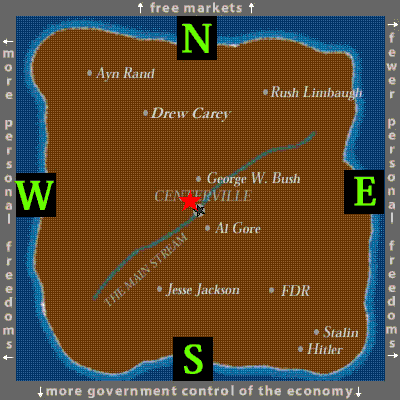Not everyone thinks that The Corporation is a book/film with good ideas. Take this news release from epublicrelations.ca:
Activist film aims to destroy the corporation:
Capitalism, democracy, health, education and environment threatened
© ePublic Relations Ltd 2004
Posted February 2004
Contact: rsirvine@epublicrelations.ca
Activists
are sending corporations on wild goose chases. At the urging of
activists, businesses are pursuing ideas such as the triple bottom
line, corporate social responsibility (CSR), and smart growth. But
these pursuits are merely ruses to keep business leaders and their PR
consultants preoccupied and distracted.
While businesses
invest enormous amounts of time and money in attempts to earn
accolades and recognition for successes in these areas, activists
have a different goal. They want to redefine, dismantle, destroy and
reassemble in a manner more to their own liking the entire
corporate world. The first step is to totally malign virtually every
corporation along with its managers, directors, shareholders and even,
in some cases, employees. What better way to do this than through a
movie!
The Corporation
has opened to critical acclaim at movie festivals in Europe and North
America. It recently won the World Cinema Documentary Audience Award at
the 2004 Sundance Film Festival.
For the films producers,
corporations and the pursuit of profit are sources of many social evils
including planetary destruction;
The documentarys web site (http://www.thecorporation.tv) states:
Self-interested,
amoral, callous and deceitful, the corporations operational principles
make it antisocial. It breaches social and legal standards to get its
way even while it mimics the human qualities of empathy, caring and
altruism. It suffers no guilt. Diagnosis: the institutional embodiment
of laissez-faire capitalism fully meets the diagnostic criteria or a
psychopath.
To
reach this judgment the film takes a creative and effective approach.
It runs through a checklist used by psychiatrists and psychologists to
diagnose mental illness. The list is based on the diagnostic criteria
of the World Health Organization and DSM IV. By going through the list,
the film attaches the following characteristics to a corporation:
callous unconcern for the feelings of others
incapacity to maintain enduring relationships
reckless disregard for the safety of others
deceitfulness: repeated lying and conning others for profit
incapacity to experience guilt
failure to conform to social norms with respect to lawful behaviours
Based
on this assessment corporation, the film concludes that corporations
are psychopaths. To support this contention, a former FBI agent
familiar with psychopathy is interviewed.
The Corporation
is playing in theatres across Canada; will be aired by TVO in Ontario,
Canada; and, American distribution is expected. DVD and VHS copies will
be available.
Must viewing for activists
The
Corporation is important viewing for activists around the world.
Regardless of the business or industry you work in - biotechnology,
banking, ranching, agriculture, transportation, manufacturing, fishing,
chemical, pharmaceutical, nanotechnology, financial services, computer,
retail, fast food, etc. -- NGOs and activists who oppose you will be
inspired and motivated by the film. And regardless of where your
business is located Canada, the United States, New Zealand,
Australia, the United Kingdom, Germany, France, Poland, India,
Pakistan, South Africa, Japan, you name it the film will successfully
recruit more activists, invigorated to challenge the corporate world.
(A visit to the films online discussion forum reveals how activists
are reacting to the film.)
In making their anti-corporate
film, the producers interviewed many people from the business world,
including spokesman for the Disney-built town of Celebration Andrea
Finger, Goodyear Tire Chairman and former CEO Sam Gibara, former Royal
Dutch Shell Chairman Sir Mark Moody-Stuart, Landor and Associates CEO
Clay Timon, Initiative Media Vice President Lucy Hughes, Canadian
Council for International Business President and CEO Robert Keyes,
Pfizer Vice President Tom Kline, Burson Marsteller Worldwide CEO Chris
Komisarjevsky, and IBM Vice President Irving Wladawsky-Berger.
The Corporation
is a powerful film. Its perspective is clear. In an interview,
commodities trader Carlton Brown says that when the terrorists directed
planes into the Twin Towers in Sept. 11, 2001, the question on brokers
minds was How much is gold up? In other interviews, the corporations
are described as modern slave owners and CEOs are seen as monsters
because corporations are monstrous.
The anti-corporate
movement is strong and getting strong. Dealing with it is probably the
most difficult and important challenge confronting PR folks. Its
certainly far more important and challenging than dealing with a
crisis. A crisis comes and goes. It’s usually pretty clear-cut and
business generally resumes when it’s over.
Activist attacks threaten democracy, health, education and environment
Attacks
on the idea of the corporate are attacks on capitalism. They are a
vague and ill-defined. When they start and when they end is impossible
to determine. They occur at anytime from any direction from any of
hundreds of special interest groups and NGOs. If they are successful,
however, they destroy capitalism and the associated democracy, both of
which have paved the way to improved health care, greater longevity,
higher education standards, enhanced environmental standards, and ever
improving standards of living around the world.
This is
grand thinking and conceptualization. Its beyond the scope of most PR
folks who focus on the next news cycle, the next fiscal quarter, and
the bottom line. Yet, if the anti-capitalism movement isn’t viewed in
this larger context, the consequences are much more dire than a merely
tarnished brand.
The Corporation
and its web site provide valuable insight to the
anti-corporate/capitalist movement. All PR folks are encouraged to view
them to understand what activists are really up to.
![]() tired
tired![]() accomplished
accomplished

